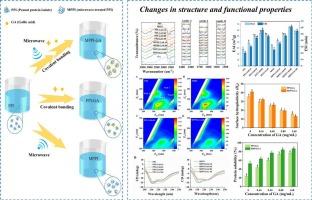A combination of microwave treatment and covalent binding of gallic acid improves the solubility, emulsification and thermal stability of peanut protein isolate
IF 8
1区 农林科学
Q1 FOOD SCIENCE & TECHNOLOGY
引用次数: 0
Abstract
This work aimed to investigate the effect of a combination of microwave treatment and covalent binding of gallic acid (GA) on the structural and functional properties of peanut protein isolate (PPI). It was found that PPI exhibited the maximum solubility at microwave power of 480 W, 60 °C for 4 min. The microwave-treated peanut protein isolates (MPPI) had more binding sites than PPI. Of these, the MPPI-GA1.60 conjugate had the highest GA binding content (436.6 nmol/g PPI). GA showed a significant effect on the secondary structure of PPI and MPPI by inducing the transition from α-helix and β-sheet to β-turn and random coil, and their rigid globular structures were disrupted to increase the molecular flexibility. The negative charges (from −39.32 mV to −54.94 mV) and average particle size (from 260.23 nm to 338.53 nm) of PPI/MPPI-GA conjugates were increased with the GA concentration and the dispersibility of conjugates was improved. Moreover, the solubility, emulsion stability and thermal stability of PPI/MPPI-GA conjugates were significantly enhanced, with the MPPI-GA0.80 conjugate being the best. It was shown that the microwave treatment and covalent binding had a synergistic effect on the improvement of the functional properties of PPI. This research may provide a new approach to improving the functional properties of PPI and help to expand the utilization of PPI in the food industry.

微波处理与没食子酸的共价结合提高了花生分离蛋白的溶解性、乳化性和热稳定性
本研究旨在探讨微波处理与没食子酸(GA)共价结合对花生分离蛋白(PPI)结构和功能特性的影响。结果表明,在微波功率为480 W、60°C、4 min时,PPI的溶解度最大。微波处理花生分离蛋白(MPPI)的结合位点比PPI多。其中,MPPI-GA1.60偶联物的GA结合含量最高(436.6 nmol/g PPI)。GA对PPI和MPPI的二级结构有显著影响,诱导它们从α-螺旋和β-片向β-转和随机线圈转变,破坏它们的刚性球形结构,增加分子柔韧性。随着GA浓度的增加,PPI/MPPI-GA偶联物的负电荷(从- 39.32 mV增加到- 54.94 mV)和平均粒径(从260.23 nm增加到338.53 nm)增加,偶联物的分散性提高。此外,PPI/MPPI-GA缀合物的溶解度、乳状稳定性和热稳定性均显著提高,其中以MPPI-GA0.80的缀合物效果最好。结果表明,微波处理与共价结合对PPI的功能性能有协同改善作用。本研究为提高PPI的功能性能提供了新的途径,有助于扩大PPI在食品工业中的应用。
本文章由计算机程序翻译,如有差异,请以英文原文为准。
求助全文
约1分钟内获得全文
求助全文
来源期刊

Food Research International
工程技术-食品科技
CiteScore
12.50
自引率
7.40%
发文量
1183
审稿时长
79 days
期刊介绍:
Food Research International serves as a rapid dissemination platform for significant and impactful research in food science, technology, engineering, and nutrition. The journal focuses on publishing novel, high-quality, and high-impact review papers, original research papers, and letters to the editors across various disciplines in the science and technology of food. Additionally, it follows a policy of publishing special issues on topical and emergent subjects in food research or related areas. Selected, peer-reviewed papers from scientific meetings, workshops, and conferences on the science, technology, and engineering of foods are also featured in special issues.
 求助内容:
求助内容: 应助结果提醒方式:
应助结果提醒方式:


